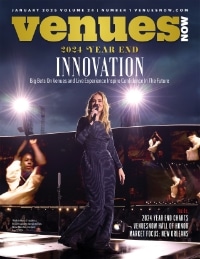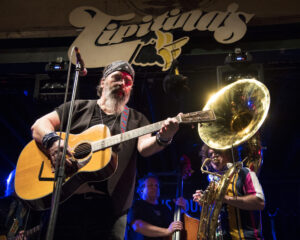DOUBLE WHAMMY: The Disney On Ice “Frozen & Encanto” production based on the two blockbuster films continues into May. (Feld Entertainment)
Feld Entertainment Machine Keeps Magic Alive, Drama On Stage
The real magic of Disney On Ice happens backstage.
Moving with the speed and precision of a NASCAR pit crew, the Feld Entertainment family spectacle transports 15 trucks, 50 skaters and a crew of 25 into a new venue every week, plus bells and whistles from snow blowers to sno-cones.
At its height, the Ellenton, Florida-based company is a finely-tuned machine producing eight shows on tour — two international and six domestic — on the road for seven to nine months at a time. The tour typically books mid-size to big league arenas with up to nine shows over four days in individual markets to meet the demand of consumers and many families with wide-eyed princesses in full regalia.
The longtime creative partnership between Feld Entertainment and the Walt Disney Company began in 1981 and has performed for more than 320 million people in 68 countries.
Rolling into a new venue every week presents its own challenges from loading docks that are little more than roll-up doorways to providing their own ice making capability. But there’s an upbeat spirit and the laminated sign on the backstage message board is a constant reminder: “All Drama Must Remain on the Stage.”
The key to their successful execution under relentless deadlines and inconsistent surroundings is planning. The semi trucks that keep the tour moving are meticulously packed, mapped out by computer drawings and spreadsheets. Every piece of equipment comes with a crate, a place for installation and an order that never varies. Every inch of available backstage real estate is filled and signs are plastered on doors with blue painters tape to lead the way to production and wardrobe.
The other necessary job requirement is a road-honed problem-solving attitude from securing paperwork and documentation for international skaters to finding on-hand solutions for broken equipment until replacements are sent from the Feld warehouse.
“One way or another, the show goes on,” quipped tour manager David Sutton.
The latest production, “Disney On Ice Presents Frozen & Encanto,” swept into the Crown Coliseum in Fayetteville, North Carolina, for its annual appearance in December before the holidays.
Lights, Props, Action

NICE ICE: Load-in takes place at Crown Coliseum ahead of performances of “Encanto” and “Frozen,” which ran Dec. 15-18. (Feld Entertainment)
Disney on Ice takes 16 hours to load into arenas. The total weight of hanging production equipment is 50,000 pounds with 84 speaker cabinets and nine subwoofer arrays.
In Fayetteville, tucked in a corner facing the stage, Brandon Hilliard, Feld Entertainment’s assistant lighting technician and board operator, intently watched riggers. Hilliard joined Feld in July after working eight years as a stagehand at the State Farm Arena and GAS South Arena in greater Atlanta, Georgia.
“Every week I’m trying to find a good view for me to see everything,” Hilliard said. “Some weeks, I’m up high, some weeks I’m in a corner. Some weeks I’m sitting at the edge of my chair, or straight standing up to be able to see everything. Most concerts, front-of-house is dead center on the floor. Every week, we are in a different location so my focus is off slightly sometimes just because of where I’m sitting.”
Transitioning to a new venue every week translates to making similar adjustments.
“Most of the time I go on the venue walk-through with the production manager,” Hilliard explained. “The main things I’m checking for are power and size to see how everything will fit. It’s always interesting trying to squeeze everything in.”
The show uses an automated lighting system, but there are spots in the production that require manual operation. Hilliard can’t use markers as guides because they would be visible on the ice. Lighting designers have to take into account the reflective ice surface’s impact.
“You’re not lighting a stage, you’re lighting an entire bowl,” Hilliard explained. “It’s a bigger challenge, because now you’re doing a wider scale vs. doing a small box. Where you’re having lights focus on one person, now you’re focusing on 30 different skaters and creating an image on the ice.”
Hilliard has to be ready for anything from a skater falling to an eager fan accidentally knocking out a light.
“When that happens, I’m hoping and praying that the light is not truly badly damaged,” Hilliard explained. “Sometimes it really is (broken) and I have to call members of the team that are on standby for incidents to help.”
Anything can happen. “Last week, most of the (prop) snow didn’t make it to the ice because the air blew it somewhere else,” Hilliard said with a laugh.
Eli Urffer, head of automation and properties assistant, was unloading crates and prepping the apparatus for the acrobatic skaters who perform 40 feet above the ice.
“Obviously we follow strict safety protocols with daily inspections,” he said. “An assistant checks the apparatus as a back-up and the performers will check as well. We are in very close communication daily about safety concerns.”
Details count and something as small as having a sloped edge on the ice matters. “We have some large props and if there was a two-inch jump from the concrete to the ice we are going to struggle to get that prop up and out on the ice,” Urffer said.
Not to mention the wear and tear on the props, which include a sleigh about 12 feet long, six feet wide and 6.5 feet tall.
“A lot of paint gets scratched and worn off,” Urffer said. “A lot of props are foam, so when they drop they bounce and if a performer hits another performer with it — if they aren’t in the right place at the right time — no real damage is being done. Well, maybe a little emotional damage.”

LOCKED AND LOADED: Each skater has a storage locker for skates. All Disney On Ice gear travels in crates, with skaters personalizing their lockers. (Feld Entertainment)
After spending six years with Feld Entertainment, Urffer said he recognizes the crew values their working relationship with the skaters. “For the crew it’s important for us to be close to the skaters because without them, we’re not doing a show.”
Skating on Thin Ice
Olympic skater Katarina Witt once said, “Figure skating is a mixture of art and sport.” At Disney On Ice, you can throw in rice paper confetti, dissolvable snowflakes and elaborate wigs and costumes. Most of the performers are former competitive skaters from around the globe. They are elite athletes transformed into beloved Disney characters .
Feld Entertainment employs 500 skaters, more than any other entertainment company in the world, according to company officials. It’s Tsungju “Clark” Yang’s job to keep them costumed and spinning as supervisor of wardrobe and wigs. He walks the thin sequined line between function and image, which is closely monitored.
“Part of the job for the costume designers is to find a design that meets Disney standards and meets our functionality,” Yang said. “We can’t have a floor-length skirt and have them go out there jumping.”
Fabric choices such as organza silk are important to give a full appearance but not add extra weight. Another trick is adding in-seam zippers to pants for quick changes over bulky skates.
Completing the changeover from short competition skirts and spandex to theatrical costumes takes practice. The troop rehearses for six weeks before launching a new show on the road.

LOOK SHARP: A technician helps keep the production — and the skaters’ blades — on the cutting edge. (Feld Entertainment)
“I think of them as still very much being an athlete, but they are an athlete on skates performing, and they have a much more demanding physicality they have to consider on top of what they are wearing in character,” Yang said.
The mix includes spins and quick stops in Broadway-style wigs. Yang said they use sewn-in wig clips in favor of bobby pins, which are a safety hazard.
For Yang, with a costume background in opera and theater, troubleshooting keeps the job interesting.
“In that sense, I’m able to problem solve and be creative,” he said. “In a show, a zipper breaks and there isn’t much you can do. But you’re trying your best to get safety pins in so they can feel secure and the character is still on (cue). The show is still going on. It’s a matter of their safety and finding creative ways to deal with the problem at hand.”
It’s professional skater Florian “Flo” Valera’s job to keep them on their toes. Valera, a professional skater from Toulouse, France, portrays principal character and love interest Kristoff in the first act of “Frozen.”
He also serves as Feld’s resident skate sharpener. Each skater provides their own skates and everyone travels with two pairs at a minimum.
Depending on the skater’s preference, it takes Valera 15 minutes to sharpen each set. His work station is set up inside a crate in a hallway near the portable lockers where the performers keep their skates.
On the ice, Valera is equally impressive vaulting over the massive sled at the end of the first act.
“The trick is my trademark,” he said. “I have a picture in my head that would describe it, but you are stepping into another world for a second. Like you don’t know where you are and you just take it in.”
Sports trainer Megan Holton keeps the performers in peak condition. The show travels with a $20,000 portable gym that’s set up in arenas for workouts dispersed around rehearsals.

SKATES UP: Performer Tiffany Beranger, who portrays Delores in “Encanto,” rehearses her aerial strap act. (Feld Entertainment)
“It helps to reduce injuries and it also helps with injury recovery,” Holton said. “An athletic trainer on tour in a professional setting is a great way to reduce the amount of people out of work due to injury. You can keep those athletes in the shows by dealing with smaller injuries that can be managed in-house, which is much nicer than having them go outside to a physical therapist or clinic.”
Being on site and traveling with the skaters has created a deep bond between the trainer and talent. “You become emotionally attached,” she admitted. “I call them my kids. They mean a lot to me and getting to go out there and watch them perform is why I do my job.”
Crowning Achievement
“I would say that Disney On Ice and our relationship with Feld is paramount to our success here at the Crown Complex,” said Seth Benalt, the arena’s general manager. “This event is tradition.”
The Crown Complex, which is managed by OVG 360, part of Oak View Group, parent company of VenuesNow, has five facilities, including 10,000-capacity Crown Coliseum, which opened in 1997 and is home to the Fayetteville Marksmen of the Southern Professional Hockey League; a smaller arena; a theater; an expo center and ballroom.
Benalt has been with Crown Complex for seven years and said the value the event brings to the community is immeasurable. The strength of ticket sales for family entertainment coming out of the pandemic expanded the number of Disney On Ice shows from seven to nine with total attendance of about 35,000.
“It’s important for us from an operating standpoint to do high-quality shows,” Benalt added. “There is no such thing as turnkey. Even if you bring in the same show, you have had before, there are always different people and changes at facilities.”
The Crown Coliseum, which operates with an ice floor from October through April for hockey, installed a new ice plant before the pandemic. Prepping the floor for Disney On Ice took the 10-person venue ice team about 40 hours, according to Chad Jeffrey, director of operations at the Crown Complex.
Feld “is a well-oiled machine. There is very little gray area,” Jeffrey said. “They don’t leave anything to interpretation. It’s my job to make sure what they want is ready when they get here.”

ICY STARE: Brandon Hilliard, Feld Entertainment’s assistant lighting technician and board operator, joined the company in July after eight years as a stagehand at State Farm Arena and GAS South Arena. (Feld Entertainment)
Eyes on The Ice: Brandon Hilliard, Feld Entertainment’s assistant lighting technician and board operator, joined the company in July after eight years as a stagehand at State Farm Arena and GAS South Arena. (Feld Entertainment)
At the conclusion of the rescheduled Alabama concert on Dec. 11, it took three hours for the coliseum crew to remove chairs, dismantle the stage and pull up the ice deck.
Once they reached the ice, it had to be cleaned and sprayed with water, a process called flooding, before painting the surface white. The process is repeated until there’s a 1.5 inch layer of ice above the painted surface.
“This is their home for a week and we want them to have the conditions that they need,” Benalt explained.
“If the ice isn’t good quality, and the artists that are out there aren’t performing their best because they are unhappy with the ice, whether it’s soft or hard or not thick enough, that impacts the end experience to the user.”
The audience is a mix of local families with visiting relatives and service families from nearby Fort Bragg, one of the largest military complexes in the world and home to the 82nd Airborne division. The base covers 250 square miles and subsequently provides a new influx of ticket buyers each year who have been reassigned from military bases around the world.
“The devil is in the details and that’s why it is so enjoyable for us to work with professionals like Feld,” Benalt said. “Anyone can put on an ice show, but to do it right, and at that level, you can’t take anything for granted.”
Show Time
Doors open one hour before show time and the aroma of freshly made popcorn permeates the concourse level of the venue. Feld Entertainment controls its own concessions operation on the road. At Crown Coliseum, there are six concession stands that sell toys, shirts, popcorn, cotton candy and sno-cones. Another six stands sell food only and there are three themed photo booths.
A 53-foot trailer of merchandise is delivered every week from the Feld warehouse. The order is based on an inventory system and attendance for the run. The booths are staffed by 28 Feld Consumer Products employees and Feld hires an additional five to 10 workers each week to help with the photo booths and food sales.
Feld Entertainment has a product and development team that creates unique merchandise specific to tours. It takes about one year from concept to consumer.
The delight Disney On Ice brings to children is as clear as the floating bubbles from hundreds of light wands.
“At the end of the show you see all the kids going out with all of these toys and things that are spinning, lights glowing and bubbles, and they are having the time of their lives,” Jeffrey said. “That’s what makes all the hard work worth it.”
“Disney On Ice” By The Numbers
Box Office Totals Reported To Pollstar and
VenuesNow for all Disney On Ice productions.
2022 Total Gross:
$78.9 million
2022 Total Tickets Sold:
2.07 million
2022 Number of Shows Reported:
488
2022 Number of Venues:
46
2022 Average Gross Per Venue:
$1.72 million
2022 Average Tickets Sold Per Venue:
44,997
Total Gross (1991-2022):
$1.21 billion
Total Tickets Sold (1991-2022):
46.68 million
Number of Shows Reported (1991-2022):
10,555








